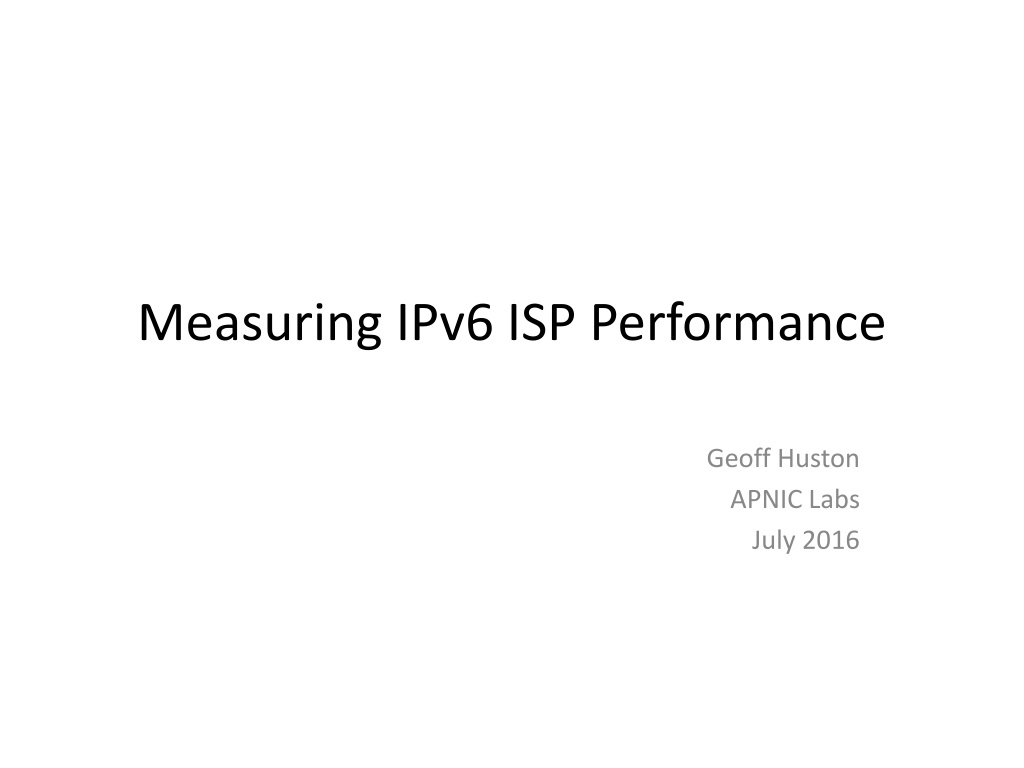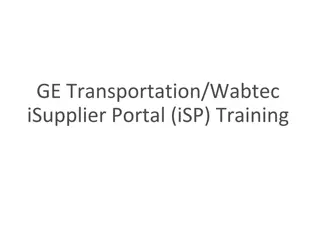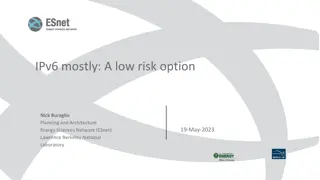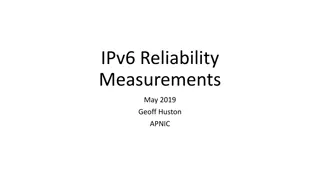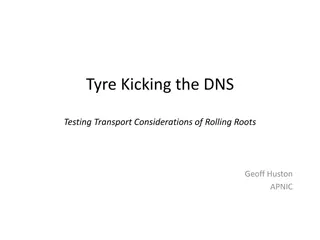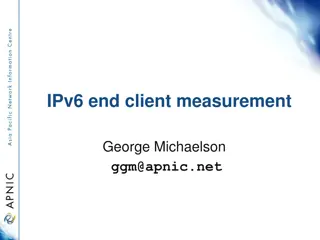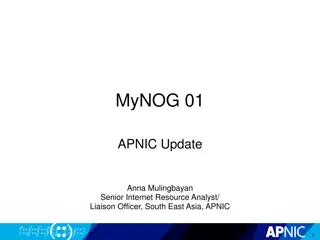Understanding IPv6 ISP Performance: A Detailed Analysis by Geoff Huston
This comprehensive study explores the reliability and speed of IPv6 connections, highlighting factors affecting connection failures. It compares datasets from 2011 and 2015/2016, revealing insights on Teredo, 6to4, and unicast address failures. The findings underscore the importance of addressing issues like firewall filters and server reliability to improve the overall performance of IPv6 connections.
Download Presentation

Please find below an Image/Link to download the presentation.
The content on the website is provided AS IS for your information and personal use only. It may not be sold, licensed, or shared on other websites without obtaining consent from the author. Download presentation by click this link. If you encounter any issues during the download, it is possible that the publisher has removed the file from their server.
E N D
Presentation Transcript
Measuring IPv6 ISP Performance Geoff Huston APNIC Labs July 2016
What are we looking at: How reliable are IPv6 connections? How fast are IPv6 connections?
What are we looking at: How reliable are IPv6 connections? How fast are IPv6 connections?
Connection Failure Outbound SYN client server Busted SYN ACK Return path Outbound ACK
Compare two data sets The first data set has been collected across 2011 Teredo and 6to4 were still active as IPv6 mechanisms Little in the way of other IPv6 services The second data set has been collected across 2015/2016
V6 Failure Rate by Address Type Teredo All V6 Average 6 to 4 Unicast
6to4 Failure is Local Failure 6to4 failure appears to be related to two factors: 1. The client s site has a protocol 41 firewall filter rule for incoming traffic (this is possibly more prevalent in AsiaPac than in Europe) 2. Load / delay / reliability issues in the server s chosen outbound 6to4 relay (noted in the data gathered at the US server) Even so, the 10% to 20% connection failure rate for 6to4 is unacceptably high!
V6 Unicast Failures January March 2012: 110,761 successful V6 connecting endpoints 6,227 failures That s a failure rate of 5.3%! 7 clients used fe80:: link local addresses 7 clients used fc00:/7 ULA source addresses 2 clients used fec0::/16 deprecated site local addresses 16 clients used 1f02:d9fc::/16 Nobody used 3ffe::/16 prefixes!
Data Set 2: Connection Failure in 2015/2016 January 2015 January 2016 40,359,805 IPv6 endpoints 1,361,256 Failure rate (3.37%)
Daily IPv6 Failures RIP Flash! HTML5 + TLS + Mobile Devices
6to4 7,693,849 6to4 endpoints 19% of all IPv6 used 6to4 9% failure rate within the set of 6to4 connections
Daily IPv6 Failures 6to4 failure rate has improved from 15%-20% in 2011 to 9% in 2015 Teredo has all but disappeared Unicast failure rate is between 1.5% and 4% in 2015 Current unicast failure rate is 2%
Killing off 6to4 Proportion of IPv6 connections using a 6to4 address
IPv6 Failures Sep 2015 Jan 2016 20,872,173 unique IPv6 Addresses 464,344 failing IPv6 addresses 142,362 6to4 addresses 138 teredo addresses 68 fe80:: local scope addresses 834 unallocated addresses 1,244 unannounced addresses 319,698 addresses from unicast allocated routed space 216,620 unique /64s
Its not good! IPv6 Unicast Failure rate: 1.6% (falling) IPv4 Failure rate: 0.2% (steady)
What are we looking at: How reliable are IPv6 connections? How fast are IPv6 connections?
Connection Failure Outbound SYN client server Return SYN+ACK Outbound ACK RTT Sample
Why SYN Handshakes? Every TCP session starts with a SYN handshake It s typically a kernel level operation, which means that there is little in the way of transport protocol or application level interaction with the SYN exchange On the downside there is only a single sample point per measurement
Generating a comparative RTT profile For each successful connection couplet (IPv4 and IPv4) from the same endpoint, gather the pair of RTT measurements from the SYN-ACK exchanges Use the server s web logs to associate a couplet of IPv4 and IPv6 addresses Use the packet dumps to collect RTT information from the SYN-ACK Exchange Plot the difference in RTT in buckets
2012 Data IPv6 is faster IPv6 is slower Number of samples (log scale) 6 to 4 Teredo Unicast RTT Difference (in fractions of a second)
December 2015/January 2016 IPv6 is faster IPv6 is slower Number of samples (log scale) Unicast RTT Difference
December 2015/January 2016 6to4 IPv6 is faster IPv6 is slower Number of samples (log scale) RTT Difference
December 2015/January 2016 IPv6 is faster IPv6 is slower Number of samples (log scale) RTT Difference
2015/6 RTT Data CDF IPv6 is faster IPv6 is slower Proportion of samples 6 to 4 Unicast RTT Difference (millisecs)
2015/6 RTT Data CDF IPv6 is slower IPv6 is faster Proportion of samples 6 to 4 Unicast RTT Difference (milliseconds)
2015/6 RTT Data CDF IPv6 is slower IPv6 is faster Proportion of samples 32% of samples unicast IPv6 is more than 10 msec slower than IPv4 6 to 4 Unicast 13% of samples unicast IPv6 is more than 10 msec faster than IPv4 Zero point is 0.44 RTT Difference (milliseconds)
Mapping the Data Convert the IPv4/IPv6 data points into Origin AS and Country Code RTT: Compute Relative RTT by simple subtraction (IPv6 RTT IPv4 RTT) Compute the Mean and the Mean Standard Deviation Strip out data points > 1 MSTD from the Mean Add data to daily Country and Origin AS data sets Connection: Compute the ratio of failed IPv6 to total seen IPv6 Add data to daily Country and Origin AS data sets
The Connection Reliability Map This is a 30 day average value of V6 systems. Units are % http://stats.labs.apnic.net/v6perf
The Relative Performance Map IPv6 IPv4 This is a 30 day average value of dual stack systems, comparing the V6 RTT to the V4 RTT by simple subtraction. Units are MS http://stats.labs.apnic.net/v6perf
Country and per-AS reports http://stats.labs.apnic.net/v6perf
Questions to you Is this helpful information? Is the layout useful or not? What other views would be helpful to you?
